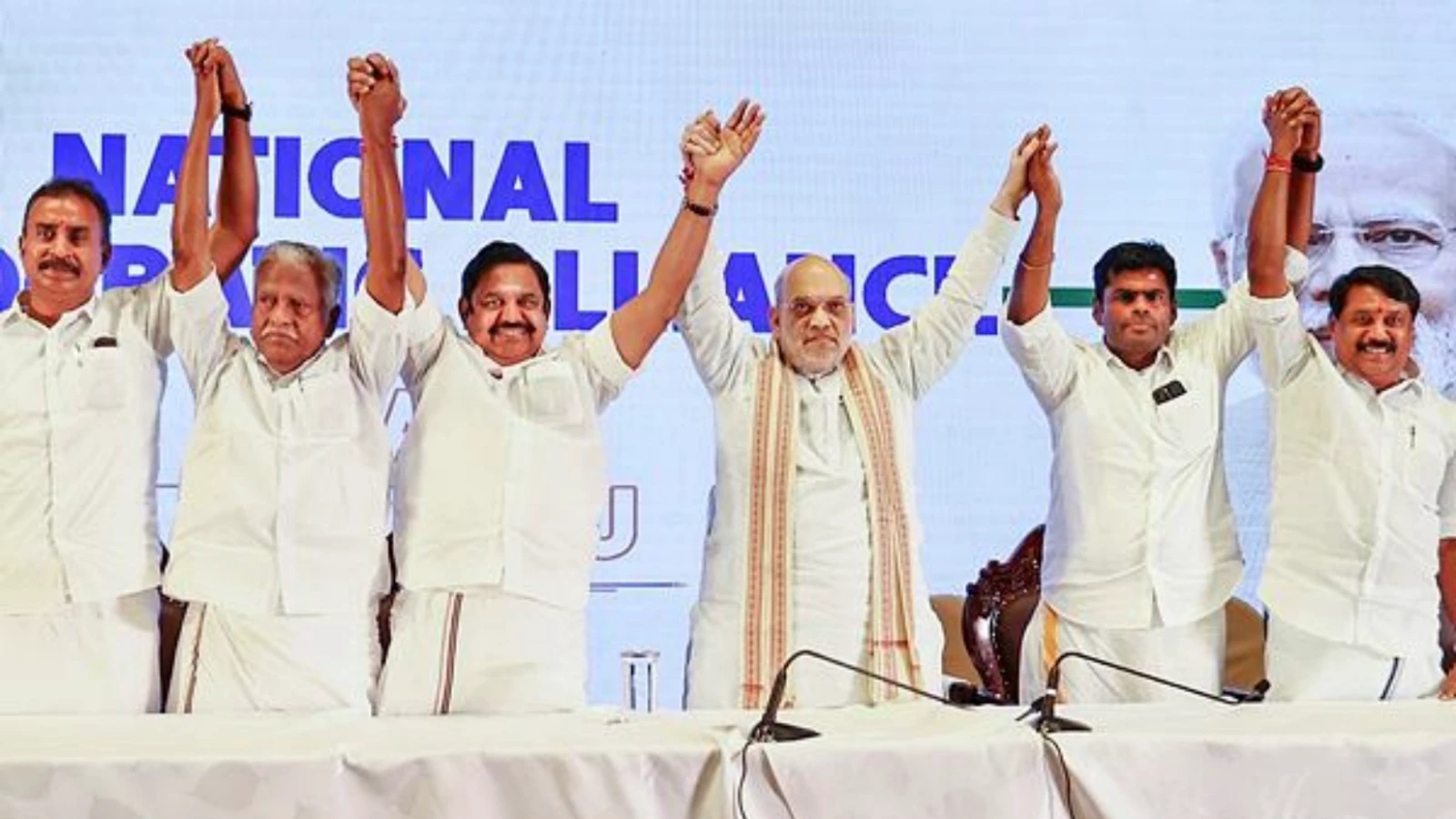Union Home Minister Amit Shah with AIADMK general secretary Edappadi K Palaniswami, Tamil Nadu BJP President K Annamalai and others during a press conference, in Chennai, Friday, April 11, 2025. (PTI Photo)
The change in the BJP’s leadership in Tamil Nadu and AIADMK’s return to the NDA, a year before the Assembly elections, has many implications. Whether Annamalai, the young and charismatic BJP leader, was replaced at the behest of the AIADMK or if the latter made it a precondition for the alliance is not yet clear. The new BJP president Nainar Nagendran, erstwhile minister in the AIADMK government, is an under-stated politician from the southern districts of Tamil Nadu and a sitting MLA from Tirunelveli. He left the AIADMK and joined the BJP after the then Chief Minister J Jayalalithaa’s demise in 2016 which was followed by many in-fights. Notably, Nagendran’s name as a possible successor to Annamalai has been floating around for some time.
The relationship between the BJP and the AIADMK has not been cordial since Annamalai became the president of the Tamil Nadu BJP. Annamalai was not on good terms with the AIADMK chief Edappadi K Palaniswami. In this context, the change in leadership of the BJP seems to be a strategic move to contain any possible internal scuffle between the alliance partners. With the AIADMK and the BJP alliance sealed and with more parties expected to join, would the NDA alliance led by Palanisami in Tamil Nadu be able to mount a serious challenge to the tried and tested coalition led by the incumbent DMK CM M K Stalin?
In the last few decades, Tamil Nadu has witnessed very closely contested assembly elections, barring 2011, when it was a wave election due to several issues such as the killing of Sri Lankan Tamils in the indiscriminate shelling by the Sri Lankan Army, the 2G spectrum case, deteriorating law and order and many scams attributed to the DMK and the Congress – alliance partners in the UPA II government. In 2016, anti-incumbency was a factor and the incumbent CM Jayalalithaa’s strategy of asking all the allies to contest in the “two leaves” symbol of the AIADMK and the emergence of a third front earned her a narrow victory by just over 1 per cent. If Vijayakanth’s DMDK had joined the DMK front, then the outcome could have been different.
After the 2016 election, Stalin became proactive in forming a strong coalition and gained many successes in the local body, Assembly and parliamentary elections. In 2021, the DMK coalition led by Stalin came back to power. Historically, the DMK has won elections by forging a coalition with the national and state parties. In the wave elections of 1967, 1971, 1984, 1991, 1996 and 2011, the margin of vote swing was around 10 per cent or more. In the 2021 elections where anti-incumbency was an important factor, the swing was only around 6.3 per cent – even with a weakened AIADMK-BJP combine post-Jayalalithaa’s demise. In many constituencies, the contest was very close. The AIADMK-led coalition was able to win 75 seats.
Against this backdrop, given a stronger NDA alliance, the 2026 elections will be a tough contest. However, actor Vijay’s new party, the TVK, and Seeman’s NTK, if they contest alone, are sure to split votes from all political parties.
The BJP’s southern strategy of harnessing the votes of the three powerful subcastes referred to as Mukkulathor, is key to NDA’s victory. Notably, Kongu Vellalar, to which Palanisami and Annamalai belong, Mukkulathor, to which the newly appointed BJP chief Nagendran belongs, and the PMK led by Ramadoss, are all aligned together now.
The Kongu Vellalar caste is strong in the western part of the state; Vanniyars are strong in the central and western parts, and the Mukkulathor dominate in the southern part of the state. The AIADMK still has a stronghold in the western and central parts of the state despite its vote share falling drastically. But it has lost significant ground in the southern part of Tamil Nadu. The BJP’s strategy to give Nagendran the charge is expected to bring in the support of the Mukkulathor.
Congress, which used to get the Christian and Muslim votes, still works for the DMK alliance as the protector of the minorities. Will there be a realignment of nationalist votes, which Congress used to harvest, in TN after a long time? Will Hindu consolidation happen over caste divisions that the DMK has used successfully for over 50 years? Can this election be framed as a nationalism vs sub-nationalism contest? The DMK is a past master of this debate and came to power after defeating the unbeatable Congress led by Kamaraj.
Only icons such as MGR and Jayalalithaa who were caste-neutral leaders were able to break this binary of national vs state or cosmopolitan vs vernacular characterisations of the DMK. The DMK used caste and highlighted their secular credentials to bring minorities into their fold. Will this trusted formula work this time too? Whether Palanisami’s strategic compromise to regain power for the AIADMK and Annamalai’s personal sacrifice in the interest of the BJP will be rewarded by the people of Tamil Nadu remains to be seen.
